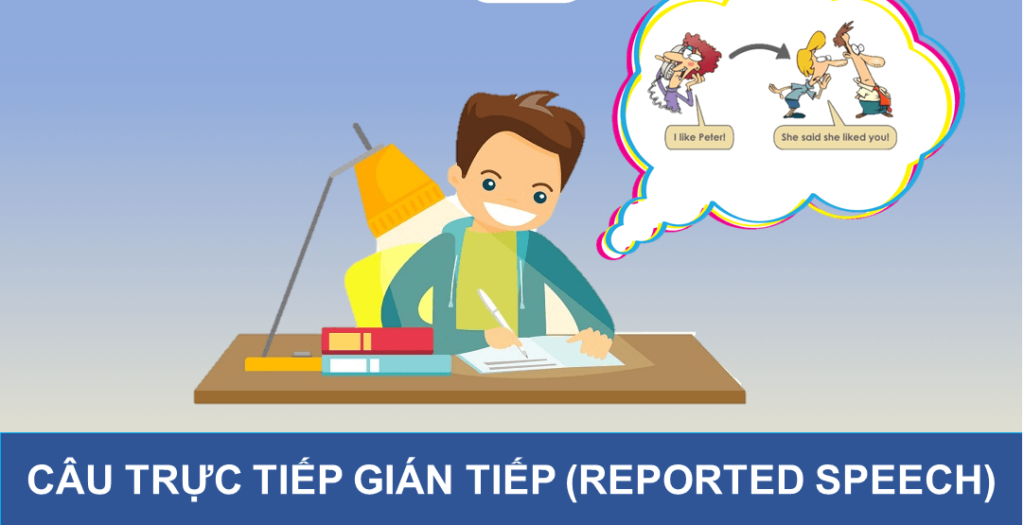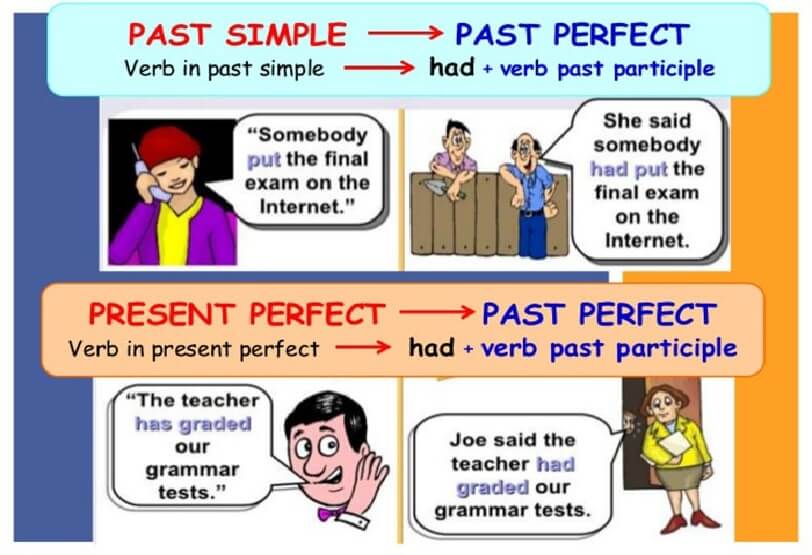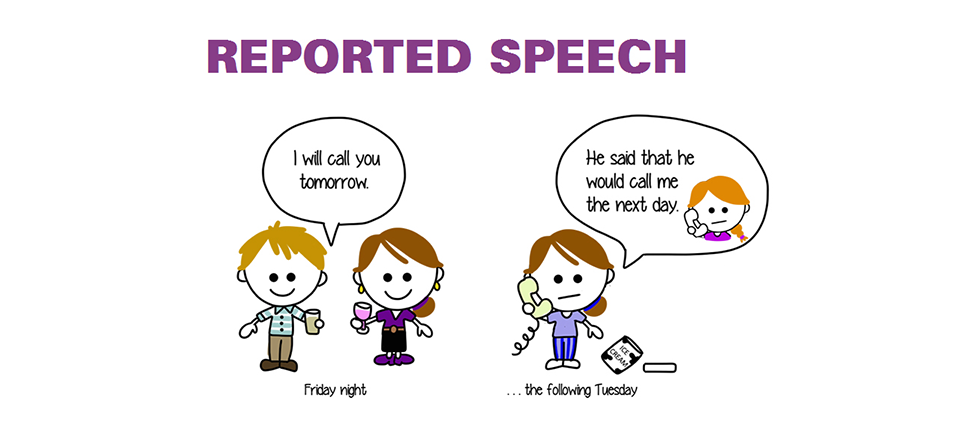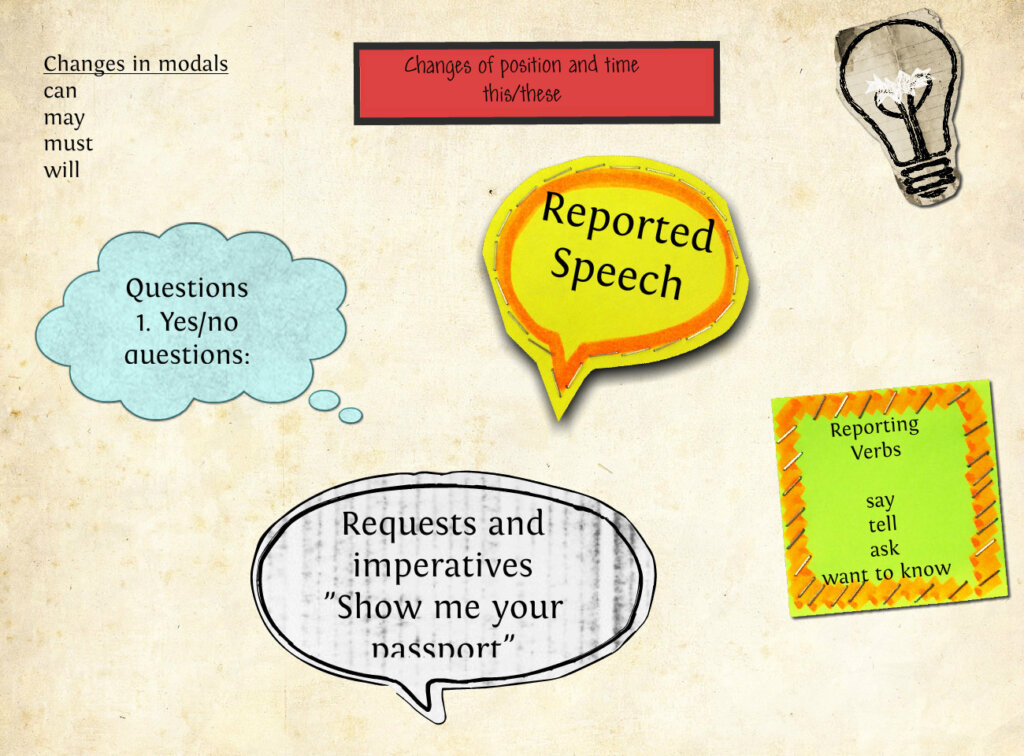Bài tập viết chuyển từ câu trực tiếp sang câu gián tiếp rất phổ biến trong những đề thi tiếng Anh. Chính vì vậy nếu bạn còn đang hoang mang về cách sử dụng và chuyển đổi câu gián tiếp và câu trực tiếp hãy tham khảo ngay bài viết dưới đây.
Trong bài viết này, ieltscaptoc.com.vn sẽ cung cấp cho các bạn kiến thức đầy đủ và chi tiết nhất về câu trực tiếp và câu gián tiếp trong tiếng Anh.
Nội dung chính
1. Khái niệm câu trực tiếp, câu gián tiếp trong tiếng Anh
Trước khi đi vào cách chuyển đổi từ câu trực tiếp sang câu gián tiếp chúng ta cần phải nắm vững khái niệm để phân biệt rõ 2 dạng câu này.

Dưới đây là khái niệm và ví dụ của câu trực tiếp và câu gián tiếp để bạn dễ học
1.1. Lời nói trực tiếp (direct speech)
Lời nói trực tiếp (direct speech): là nói chính xác điều người nào đó diễn đạt (còn gọi là trích dẫn). Lời của người nói sẽ được đặt dưới dấu ngoặc kép.
Ví dụ
She said: ”The exam is difficult”. (Cô ấy nói: “Bài kiểm tra này khó”)
1.2. Lời nói gián tiếp (indirect speech)
Lời nói gián tiếp – câu tường thuật (indirect speech): Là thuật lại lời nói của một người khác trong dạng gián tiếp, không sử dụng dấu ngoặc kép.
Ví dụ: Hoa said, ”I want to go home”
->Hoa said she wanted to go home là câu gián tiếp (indirect speech)
2. Phân biệt câu trực tiếp – câu gián tiếp trong tiếng Anh
- Câu trực tiếp (direct speech) là câu nói của người nào đó được trích dẫn lại nguyên văn và thường được để dưới dấu ngoặc kép (“…”).
Ví dụ: “I love shopping”, Sam said.
(Sam ấy đã nói “Tôi yêu mua sắm”)
- Câu gián tiếp (indirect/reported speech) là câu tường thuật lại lời nói của người khác theo ý của người tường thuật mà ý nghĩa không thay đổi.
Ví dụ: Sam said that she loved shopping.
(Sam đã nói cô ấy yêu mua sắm)
3. Cách chuyển đổi câu trực tiếp thành gián tiếp trong tiếng Anh
Để chuyển câu trực tiếp sang câu gián tiếp, chúng ta chỉ cần ghép nội dung tường thuật vào sau động từ tường thuật và thực hiện những biến đổi sau
Nguyên tắc cần nhớ khi chuyển từ câu trực tiếp sang gián tiếp
- Đổi ngôi, đổi tân ngữ
- Lùi thì
- Đổi cụm từ chỉ thời gian, nơi chốn
3.1. Cách lùi thì của câu
Nếu động từ tường thuật (reporting verb) của câu tại thì quá khứ thì phải lùi động từ chính về quá khứ một bậc khi chuyển từ lời nói trực tiếp (direct speech) sang lời nói gián tiếp (indirect/reported speech) theo quy tắc sau
| STT | Câu trực tiếp | Câu gián tiếp |
| 1 | Hiện tại đơn | Quá khứ đơn |
| 2 | Hiện tại tiếp diễn | Quá khứ tiếp diễn |
| 3 | Hiện tại hoàn thành | Quá khứ hoàn thành |
| 4 | Hiện tại hoàn thành tiếp diễn | Quá khứ hoàn thành tiếp diễn |
| 5 | Quá khứ đơn | Quá khứ hoàn thành |
| 6 | Quá khứ tiếp diễn | Quá khứ hoàn thành tiếp diễn |
| 7 | Quá khứ hoàn thành | Quá khứ hoàn thành tiếp diễn |
| 8 | Quá khứ hoàn thành tiếp diễn | Quá khứ hoàn thành tiếp diễn |
| 9 | Tương lai đơn giản | Tương lai đơn trong quá khứ (would/shoud) |
| 10 | Tương lai gần | Tương lai gần trong quá khứ (was/were going to) |
| 11 | Tương lai tiếp diễn | Tương lai tiếp diễn trong quá khứ |
| 12 | Tương lai hoàn thành | Tương lai hoàn thành |
| 13 | Tương lai hoàn thành tiếp diễn | Tương lai hoàn thành tiếp diễn trong quá khứ |

Một số trường hợp đặc biệt không lùi thì khi chuyển từ câu trực tiếp sang câu gián tiếp
- Sự thật, sự việc luôn luôn đúng
“The earth moves round the sun” he said. –> He said that the earth moves round the sun.
- Nếu động từ tường thuật (reporting verb) chia ở các thì hiện tại
Chúng ta giữ nguyên thì của động từ chính và các trạng từ chỉ nơi chốn cũng như trạng từ chỉ thời gian trong câu trực tiếp khi chuyển sang gián tiếp.
Ví dụ: He says: “I’m going to New York next week.”
-> He says he is going to New York next week.
- Câu điều kiện loại II và III
Ví dụ: “If I were you, I would leave here” he said.
->He said that if he were me, he would leave there.
- Wish + past simple/ past perfect
Ví dụ: “I wish I lived in Da Nang”, he said.
-> He said he wished he lived in Da Nang.
- Cấu trúc “it’s time somebody did something”
Ví dụ: “It’s time he woke up”, she said.
-> She said it was time he woke up.
- Would/ should/ ought to/ had better/ used to không chuyển

Ví dụ: “You’d better work hard” he said
-> He said that I had better work hard.
3.2. Biến đổi đại từ, tân ngữ và tính từ sở hữu
| STT | Câu trực tiếp | Câu gián tiếp |
|---|---|---|
| 1 | I | He/She |
| 2 | We | They |
| 3 | You | He/She/I/They |
| 4 | me | him/her |
| 5 | us | them |
| 6 | you | him/her/me/them |
| 7 | myself | himself/herself |
| 8 | ourselves | ourselves |
| 9 | yourself | himself / herself / myself |
| 10 | yourselves | themselves |
| 11 | my | his / her |
| 12 | our | their |
| 13 | your | his / her / my/ their |
3.3. Biến Đổi 1 Số Động Từ Khuyết Thiếu
| STT | Câu trực tiếp | Câu gián tiếp |
| 1 | Can | Could |
| 2 | May | Might |
| 3 | Must | Had to |
| 4 | Will | Would |
| 5 | Shall | Should |
3.4. Biến Đổi Một Số Trạng Từ Chỉ Thời Gian, Nơi Chốn
Chuyển đổi những trạng từ chỉ thời gian và nơi trốn là những lỗi các bạn học sinh hay mắc phải nhất. Hãy tham khảo bảng chuyển đổi dưới đây để tránh những lỗi chuyển đổi này nhé.
| STT | Câu trực tiếp | Câu gián tiếp |
|---|---|---|
| 1 | Here | There |
| 2 | This | That |
| 3 | These | Those |
| 4 | Today | That day |
| 5 | Tonight | That night |
| 6 | tomorrow | The next day/ The following day |
| 7 | Next week | The following week |
| 8 | Yesterday | The day before/ The previous day |
| 9 | Last week | The week before/ The previous week |
| 10 | The day after tomorrow | In 2 days’ time |
| 11 | The day before yesterday | Two days before |
| 12 | Now | Then |
| 13 | Ago | Before |
4. Câu Trần Thuật Gián Tiếp Trong Tiếng Anh
Khi biến đổi câu trần thuật từ trực tiếp sang gián tiếp, chúng ta dùng một số động từ tường thuật: say (that), tell sb (that)

Thực hiện một số biến đổi thiết yếu về đại từ, tân ngữ, tính từ sở hữu,…và lùi thì nếu động từ tường thuật chia tại thì quá khứ.
S + said /said to sb that/ told sb that + Clause
Ví dụ 1: “I am going to buy this house next month”, she said.
-> She said that she was going to buy that house the following month.
Ví dụ 2: “I am going to buy this house next month”, she said.
-> She said that she was going to buy that house the following month.
GỢI Ý: Một số bài viết có thể bạn sẽ quan tâm:
- Thì hiện tại tiếp diễn (Present Continuous) – Cách dùng, Công Thức và Bài Tập ứng dụng
- Full công thức & Dùng Thì tương lai tiếp diễn (Future continuous)
- Những dấu hiệu nhận biết thì Tương lai đơn – Simple future tense
5. Câu Hỏi Gián Tiếp Trong Tiếng Anh
5.1. Câu Hỏi Yes/No
Động từ tường thuật sử dụng: ask, wonder, want to know
Thêm if/whether sau động từ tường thuật
S + asked (sb) / wondered / wanted to know + if/whether + Clause
Ví dụ: “Do you love camping?, Nam asked.
-> Nam asked me if I loved camping.
Chú ý: Nếu trong câu trực tiếp có từ “or not” thì trong câu gián tiếp bắt buộc dùng “whether”.
Ví dụ: “Does Lan like apple or not?”, he asked.
-> He wondered whether Lan liked apple or not.
5.2. Câu Hỏi Wh-Questions
Động từ tường thuật thường sử dụng: ask, wonder, want to know
Sau động từ tường thuật là từ để hỏi và mệnh đề (lùi thì nếu cần thiết) không đảo ngữ
S+ asked (sb) / wondered/ wanted to know + Wh-word + S+ V (thì)
Ví dụ: “How do you go to school?”, my teacher asked.
-> My teacher wanted to know how I went to school.
6. Câu Mệnh Lệnh Gián Tiếp Trong Tiếng Anh
Câu khẳng định
S + asked/ told/ required/ requested/ demanded + O + to V
Ví dụ: “Turn down the music, please.”, he said.
-> He told us to turn down the music
Câu phủ định
S + asked/ told/ required/ requested/ demanded + O + not + to V
Ví dụ: “Don’t smoke in this room.”, she said to Nam.
-> She told Nam not to smoke in that room.
Câu mệnh lệnh
Khi câu trực tiếp mang nghĩa ra lệnh, ta dùng động từ tường thuật order
Order sb to do st
Ví dụ: He said to me angrily: “Go out!”
-> He ordered me to go out.
7. Cách chuyển đổi câu gián tiếp cơ bản
Trong tiếng Anh có rất nhiều những mẫu câu riêng nên tùy từng mẫu câu sẽ có cách chuyển từ câu trực tiếp sang câu gián tiếp khác nhau.

Dưới đây là cách chuyển đổi những mẫu câu cơ bản từ câu trực tiếp sang câu gián tiếp.
Cách chuyển đổi 1
Câu bị động có thể sử dụng những động từ: agree (đồng ý), refuse (từ chối), offer (đề nghị), promise (hứa), threaten (đe dọa) để tường thuật lại ý nghĩa của câu chủ động
Cấu trúc
S + agree/refuse/offer/promise/threaten/ +to V
Ví dụ
- “All right, I’ll help you” he said. –> He agreed to help me.
- “ Oh, no, I won’t come to your party”, he said. –> He refused to come to my party.
- “I’ll look for the cat for you tomorrow if you like” he said. –> He offered to look after the cat for me the next day if I liked.
- “I’ll visit your parents when I arrive there”, he said –> He promised to visit my parents when he arrived there.
- “I’ll sell the TV set if you keep on watching it all day”, said the father –> the father threatened to sell the TV set if he kept on watching it all day
Cách chuyển đổi 2
Câu bị động có thể sử dụng những động từ: accuse …of (buộc tội), admit (thừa nhận), apologise for (xin lỗi), deny (từ chối), insist on (khăng khăng) để tường thuật lại câu chủ động
Cấu trúc
S + accuse/admit/apologise/deny/insist on + V-ing
Ví dụ
- “You stole the jewels.” said the inspector –> the inspector accused her of stealing the jewels.
- “I’ve made the wall dirty.” said one student. –> One student admitted making the wall dirty.
- “I’m sorry I’m late.” she said. –> She apologized for being late.
- “No, we didn’t enter the garden.” said the boy. –> the boy denied entering my garden.
- “Certainly, I’ll buy that car for you”, said he. –> He insisted on buying me that car.
Cách chuyển đổi 3
Say to somebody + a statement –> told somebody + that + clause
Ví dụ: “I’ve finished all my homework”, he said to me.
–> He told me that he had finished all his homework.
Cách chuyển đổi 4
Say + a statement –> said that + clause
Ví dụ: “I’m going to Hanoi tomorrow”, he said.
–> He said that he was going to Hanoi the next day.
Cách chuyển đổi 5
Statement with command, request, advice, invitation, offer –> advise, ask, beg, encourage, invite, order, tell, warn, remind…
Ví dụ
- “You’d better hurry”, he said. –> He advised me to hurry.
- “Post the letter for me, will you?”he said. –> He asked me to post the letter for him.
- “Make another try, please”, he said. –> He encouraged me to make another try
- “Don’t drive too fast”, he said. –> He warned me not to drive too fast.
- “Remember to close the door”, he said. –> He reminded me to close the door.
- “Don’t forget to come at 6 a.m tomorrow”, he said. –> He reminded to come at 6 a.m the next day.
Cách chuyển đổi 6
Questions with “shall I…”
- About future event (sự kiện trong tương lai)
Ví dụ: “Shall we attend the meeting tomorrow”, she said.
–>She asked if they would attend the meeting the next day
- Request for instruction or advice (Lời hướng dẫn hoặc lời khuyên)
Ví dụ: “Shall I read it, mother?” ha said.
–> He asked his mother if he should read it.
- Offer to do something
Ví dụ: “Shall we bring you some new books?” she said.
–> She offered to bring me some new books.
- Suggest to do something
Ví dụ: “Shall we go to the cinema tonight”, he said.
–> He suggested going to the cinema that night.
Cách chuyển đổi 7
Questions with “Will you, would you, could you…?” (yêu cầu, đề nghị, mời)–> offer, invite, order, ask, told.
Ví dụ
- “ Will you come to my party tomorrow?” he said. –> He invited me to come to his party the next day.
- “Could you get ready at 6p.m tonight?” he said. –> He told/asked me to get ready at 6p.m that night.
- “Would you like some cigarettes?” he said. –> He offered me some cigarettes.
- “Will you shut your mouth?” he said. –> He ordered me to shut my mouth.
Cách chuyển đổi 8
- Let’s do…–> suggest + V-ing (nếu bao gồm cả người nói thực hiện hành động)
- Let’s do…–> suggest + that S should do…(có thể bao gồm hoặc không bao gồm người nói thực hiện hành động)
Ví dụ 1: “Let’s go to the cinema tonight”, he said.
–> He suggested going to the cinema that night.
–> He suggested that they should go to the cinema that night
- Yes, let’s do…–> agree
- No, let’s not do… –> be against the idea.
Ví dụ: “No, let’s not” said the father.
–> The mother suggested eating out that night and the son agreed but the father was against the idea.
Cách chuyển đổi 9
Câu cảm thán trong lời nói gián tiếp
What + a + noun/how + adj –> said that + clause
Những động từ có thể sử dụng trong câu gián tiếp
- Gave an exclamation of delight (vui mừng, tán thưởng)
- Disgust (phẫn nộ)
- Honor (sợ)
- Surprise (ngạc nhiên)
Ví dụ 1: “How beautiful the picture is”, he said.
–> He said that the picture was beautiful (He gave an exclamation of delight.)
Ví dụ 2: “What a dirty kitchen!” she said.
–> She said that the kitchen was dirty. (She gave an exclamation of disgust.)
Ví dụ 3: “How wonderful”, he said.
–> He said that it was wonderful. (He gave an exclamation of surprise.)
Cách chuyển đổi 10
“Yes/no” –> subject + trợ động từ
Ví dụ 1: “Have you finished your homework?”he said. “Yes”, she said
–> He asked her if she had finished her homework and she said she had.
Ví dụ 2: “Are you ready for the exam?” he said. “No”, she said.
–> He asked if she was ready for the exam and she said she wasn’t.
Cách chuyển đổi 11
“Thank”–> subject + thanked

Ví dụ 1: “Would you like to have dinner with me tonight?”, he said. “thank you, I’d love to” she said.
–> He invited her to have dinner with him that night. She thanked him and said she would love to.
Ví dụ 2: “Good luck”, he said
–> He wished me luck.
Ví dụ 3: “Congratulation!”, he said
–> He congratulated me.
Các bài viết về từ vựng tiếng Anh đáng chú ý
- Tổng hợp thuật ngữ tiếng Anh chuyên ngành xây dựng
- Tổng hợp từ vựng tiếng Anh chuyên ngành y dược
- Tổng hợp từ vựng chuyên ngành kế toán đầy đủ nhất
8. Bài tập về câu trực tiếp và câu gián tiếp trong tiếng Anh
Bài tập 1
Chuyển các câu sau sang câu gián tiếp
- He said, “I like this song.”
- “Where is your sister?” she asked me.
- “I don’t speak Italian,” she said.
- “Say hello to Jim,” they said.
- “The film began at seven o’clock,” he said.
- “Don’t play on the grass, boys,” she said.
- “Where have you spent your money?” she asked him.
- “I never make mistakes,” he said.
- “Does she know Robert?” he wanted to know.
- “Don’t try this at home,” the stuntman told the audience.
- “I often have a big hamburger.”, Benjamin says.
- “If I were you, I’d stop taking tranquizllers. They won’t be good for you health in the long run,” I said.
- Frank: “How much pocket money does Lisa get?”
- “Don’t touch that wire, will you,” said the mother.
- Patricia: “My mother will celebrate her birthday next weekend.”
- “I’m sorry I’m late,” he said.
- “Shall I do the cleaning up for you?” he said.
- “If I were you, I would buy that book ”, she said.
- “Why don’t we go to the cinema tonight?” he said.
- “Would you like to come to my birthday party next Saturday?” she said.
- “Let’s go swimming this Sunday”, he said.
- “ Shall I carry the bag for you?” he said.
- “What a beautiful dress!” she said.
- “How ugly!” he said.
- “Remember to lock the door” she said.
Đáp án bài tập 1
- He said he liked that song.
- She asked me where my sister was.
- She said that she didn’t speak Italian.
- They asked me to say hello to Jim.
- He said the film had began at seven o’clock.
- She told the boys not to play on the grass.
- She asked him where he had spent his money.
- He said he never made mistakes.
- He wanted to know if she knew Robert.
- The stuntman advised the audience not to try that at home.
- Benjamin says that he often has a big hamburger.
- I advised her to stop taking tranquillizers and explained that they wouldn’t be good for her health in the long run.
- Frank asked how much pocket money Lisa got.
- The mother warned the child not to touch the wire.
- Patricia said that her mother would celebrate her birthday the following weekend.
- He apologized for being late.
- He offered to do the cleaning up for me.
- She advised me to buy that book.
- He suggested going to the cinema that night.
- She invited me to come to her birthday party the following Saturday.
- He suggested going swimming that Sunday.
- He offered to carry the bag for me.
- She complimented me on my beautiful dress.
- He said/exclaimed that it was ugly.
- She reminded me to lock the door.
Bài tập 2
Viết lại các câu sau
1. “Where is my umbrella?” she asked.
She asked……………………………………….………………….
2. “How are you?” Martin asked us.
Martin asked us………………………………………….……………….
3. He asked, “Do I have to do it?”
He asked……………………………………….………………….
4. “Where have you been?” the mother asked her daughter.
The mother asked her daughter………………………………………………………….
5. “Which dress do you like best?” she asked her boyfriend.
She asked her boyfriend…………………………………………………………..
6. “What are they doing?” she asked.
She wanted to know……………………………………….…………………
7. “Are you going to the cinema?” he asked me.
He wanted to know………………………………………..…………………
8. The teacher asked, “Who speaks English?”
The teacher wanted to know………………………………………..…………………
9. “How do you know that?” she asked me.
She asked me………………………………………….……………….
10. “Has Caron talked to Kevin?” my friend asked me.
My friend asked me………………………………………….……………….
Đáp án bài tập 2
- She asked where her umbrella was.
- Martin asked us how we were.
- He asked if he had to do it.
- The mother asked her daughter where she had been.
- She asked her boyfriend which dress he liked best.
- She wanted to know what they were doing.
- He wanted to know if I was going to the cinema.
- The teacher wanted to know who spoke English.
- She asked me how I knew that.
- My friend asked me if Caron had talked to Kevin.
Bài viết đã cung cấp toàn bộ kiến thức chi tiết và đầy đủ nhất về câu gián tiếp và câu trực tiếp. Bên cạnh đó ieltscaptoc.com.vn đã tổng hợp cho các bạn bài tập để luyện tập về cách chuyển đổi câu trực tiếp sang câu gián tiếp. Chúc các bạn học tập thật tốt!

